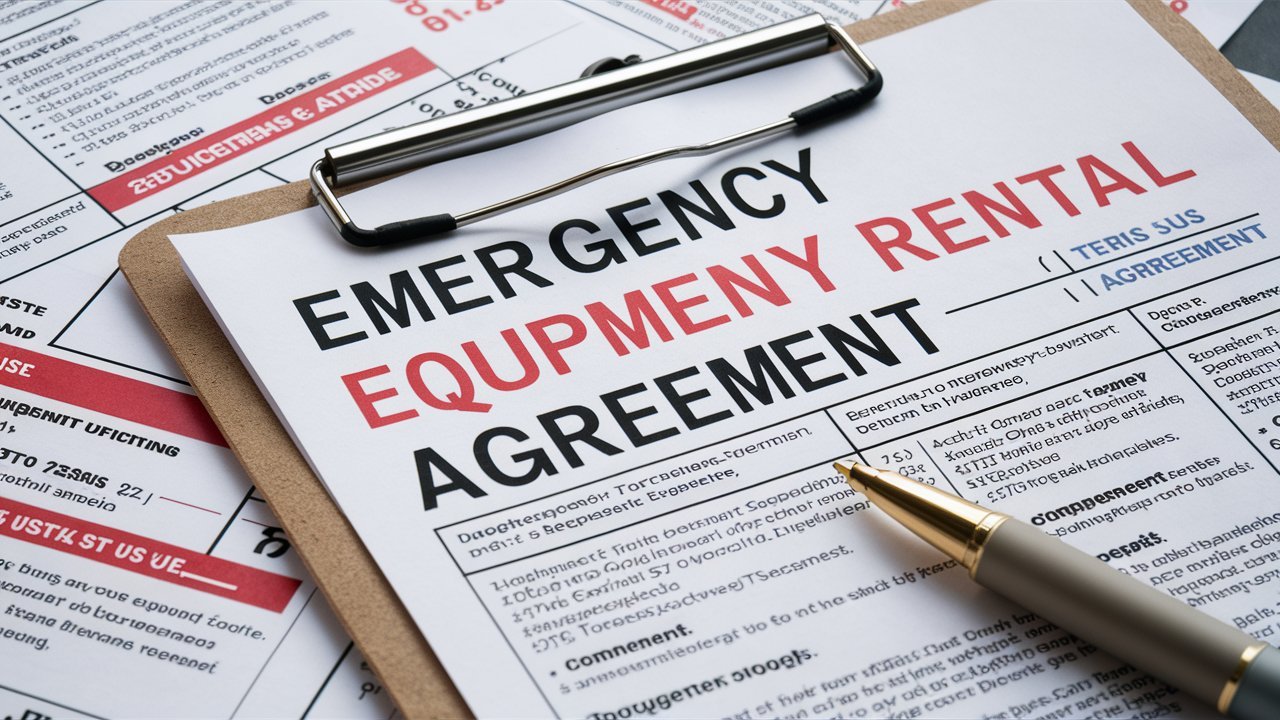In the realm of emergency preparedness, having the right equipment can make all the difference. However, acquiring such equipment on short notice can be challenging. This is where emergency equipment rental agreements come into play. Whether you’re a business owner, event organizer, or individual in need of specialized equipment during emergencies, understanding the ins and outs of rental agreements is crucial.

Understanding Emergency Equipment Rental Agreements
An emergency equipment rental agreement is a legally binding contract between a lessor (the equipment owner) and a lessee (the individual or organization renting the equipment) that outlines the terms and conditions of renting emergency equipment. These agreements typically cover details such as rental duration, payment terms, responsibilities of both parties, liability, insurance requirements, and procedures for equipment return.
What Does the Agreement Include?
An emergency equipment rental agreement typically includes:
- Identification of Parties: Clearly stating the names and contact information of both the lessor and lessee.
- Description of Equipment: Providing detailed descriptions of the equipment being rented, including model numbers, specifications, and any accessories.
- Rental Duration: Specifying the start and end dates of the rental period.
- Rental Fee: Outlining the total cost of the rental, including any applicable taxes or fees.
- Payment Terms: Detailing when and how payments should be made.
- Security Deposit: Stipulating whether a security deposit is required and the conditions for its return.
- Insurance Requirements: Specifying any insurance coverage required for the rented equipment and who is responsible for obtaining it.
- Maintenance and Repairs: Clarifying the responsibilities of both parties regarding equipment maintenance and repairs.
- Liability and Indemnification: Defining each party’s liability in case of damage, loss, or injury related to the rented equipment.
- Termination Clause: Outlining conditions under which either party can terminate the agreement.
- Dispute Resolution: Establishing procedures for resolving disputes that may arise during the rental period.

Creating an Emergency Equipment Rental Agreement
Step 1: Determine Your Needs
Before drafting an emergency equipment rental agreement, assess your specific needs. Consider the type of equipment required, rental duration, budget constraints, and any insurance or liability concerns.
Step 2: Research Rental Providers
Research reputable rental providers in your area and compare their offerings, prices, and terms. Choose a provider that offers the equipment you need at competitive rates and has a track record of reliability.
Step 3: Negotiate Terms
Once you’ve selected a rental provider, negotiate the terms of the rental agreement. Pay close attention to rental duration, pricing, insurance requirements, and liability provisions. Ensure that all terms are clearly documented and agreed upon by both parties.
Step 4: Review the Agreement
Carefully review the rental agreement before signing to ensure that all terms are accurately reflected and that you understand your rights and obligations as a lessee. Seek clarification on any unclear or ambiguous provisions.
Step 5: Sign the Agreement
Once you’re satisfied with the terms, sign the rental agreement along with the lessor. Retain a copy for your records and adhere to the terms outlined throughout the rental period.
FAQs (Frequently Asked Questions)
- What is the purpose of an emergency equipment rental agreement? An emergency equipment rental agreement serves to formalize the terms and conditions of renting emergency equipment, providing clarity and protection for both parties involved.
- How long does an emergency equipment rental agreement typically last? The duration of an emergency equipment rental agreement can vary depending on the specific needs and circumstances of the lessee, ranging from short-term rentals for a few days to long-term leases spanning several months.
- Who is responsible for maintaining the rented equipment? Maintenance responsibilities are typically outlined in the rental agreement and may vary depending on the nature of the equipment and the terms negotiated between the lessor and lessee. In general, the lessee is responsible for maintaining the equipment in good condition during the rental period.
- Is insurance required for rented emergency equipment? Insurance requirements for rented emergency equipment may vary depending on the lessor’s policies and the nature of the equipment being rented. It’s advisable to clarify insurance requirements with the rental provider and ensure adequate coverage is in place to protect against liability.
- What happens if the rented equipment is damaged or lost? The rental agreement should outline procedures for handling damage, loss, or theft of the rented equipment, including liability provisions and any applicable penalties or fees. It’s important to report any damage or loss to the lessor promptly and adhere to the terms of the agreement.
- Can the rental agreement be terminated early? Depending on the terms negotiated between the parties, the rental agreement may include provisions for early termination under certain circumstances. It’s essential to review the termination clause of the agreement and understand the conditions under which either party can terminate the agreement prematurely.
Conclusion
In summary, an emergency equipment rental agreement is a vital tool for ensuring access to essential equipment during emergencies while protecting the interests of both lessors and lessees. By understanding the key components of these agreements and following the steps outlined in this guide, you can navigate the rental process with confidence and prepare effectively for unforeseen circumstances.

